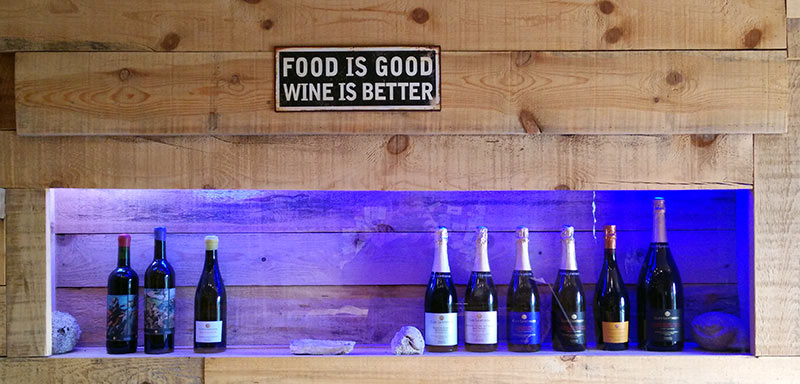For anyone in wine, you’ve probably been constantly hearing how this generation or that generation or men or women or fill-in-the-blank is “now buying wine via social media!” Most of these articles usually make big claims, but once you get about halfway through, out comes the fact that while they may be on Facebook, they’re actually just buying ads and ultimately, getting wine sold comes down to good distribution. But of course, that’s boring and not headline-y.
I’ve most definitely been on record as questioning both selling wine via social media as well as the value of “influencers” in wine and social media. This usually earns me angry comments asking as to how the weather is up my ass but still, I persist as I find there is a great deal of bullshit surrounding social media and I’m bullshit-averse which probably means choosing wine for an occupation was a mistake. Unfortunately, wine is very tasty so I soldier on.
Despite this preamble, there is indeed some value to being out there on the web and sure, social media. Will it sell your wine? No, that’s always been hard work but it will definitely help in the way that business cards or a mobile phone will help. That said, a minimal approach method is advised because honestly, social media can be a massive time suck and if it’s not something you enjoy doing, it’s going to be onerous.
What gives me the right to make these suggestions? I actually starting working in the marketing department of a well-known winery in Napa 20 years ago. Then I worked in the web as a programmer for ages, including the social media era prior to shifting to working full time in wine now.
This is not meant as an end-all be-all guide. These are just some suggestions based upon real-life instances that I’ve seen work and not work so you can take or leave as much as you’d like. I’m mainly providing it so that the next time some social media services company contacts you, you can make an intelligent decision if they can improve what you already have or you can tell them to hit the road.
Website
It pretty much goes without saying that you should own your own domain and have some kind of website set up. It doesn’t need to be really anything, just one page with your contact info and maybe a list of your wines although this is often easily found on the web these days if you have a good distributor. A website is super cheap at like $20 or less a year and you must have some not too distant family member that can cobble it together if it seems like putting it up is akin to scaling Kilimanjaro.
Why is this important? Well, if you don’t have it, other websites will emerge when people Google you and you’ll have no control over what they are. Google really wants to make singingcatwines.com be the first result when people search for “Singing Cat Wines” so go ahead and let it. Yes, there are famous wineries that get on fine without a website, but they earned fame a long time before the web existed so don’t use them as examples.
Lastly, don’t you want your email to be winery@singingcatwines.com instead of singingcatwines@yahoo.com? Yes, you do, unless you’re a French winery in which case we’ve all long accepted that every French winery shall be contacted via an @orange.fr address. Macron is apparently working to make this the law.
Blog
You’re reading this on what is essentially a blog and I enjoy wine blogging, but for a winery, meh. Blogs need a good deal of upkeep to have them be fresh, exciting, and worth visiting. To a large extent, the medium is having a lull at the moment so do with this as you’d like and if you enjoy writing, a blog might suit you well. If you set up a website at say WordPress, then the blog comes along for the ride so you can choose to do it or not, whenever you want.
Google Maps
Say whatever you want about Google, but their Maps have become the dominant way people find things online and if you want your winery found, make sure it’s there.
This used to be a super wonky process but these days it’s gotten much more sane. At Google My Business you can create a listing that will appear on Google Maps accurately. You can also monitor views, reviews, and have finite control over your opening hours. This can save you a lot of work as you then won’t get people showing up on days when you’re closed. Will this sell more wine? If you’re reliant on tasting room sales it will.
The down side? You need to have a Google account (aka GMail) and you need to have a mailing address for them to send a postcard to in order to physically verify your physical address. This is one of its shortcomings in that if you change addresses (say your tasting room moves to another street) it will take a couple of weeks to update it. But that’s the trade off for it being reliable.
Here’s where things start getting tricky. Honestly, Facebook sucks but unfortunately 1/3 of the population of the world has an account on it. These days, unless you pay up, it will serve you little purpose in terms of getting your wines known. That said, creating a page isn’t a bad idea as it gives people something to tag if they want to talk about your wines in posts. More important than interactions with this page is the fact that once you have your address set up, this transfers to other Facebook properties, most importantly, Instagram. Make note that if your winery isn’t showing up as a location on Instagram, create a Facebook page with a street address for it.
Facebook has the advantage that it’s free and a lot of people will often use it in lieu of having a website. Absolutely do not do that. As shown in recent discoveries, Facebook is not a loving partner in any relationship and while it’s good to have a presence, don’t make it your only presence.
Much like Facebook, Twitter has the problem that unless you’re very active, constantly posting tweets, you get little from it. This can take up a lot of time for a winemaker and to keep it “juiced” requires someone working on it quasi full time. But again, like Facebook, having an account is advisable if for no other reason than to claim your brand. Sign up, post a tweet with a nice photo of your vineyards, make sure there’s your website in the bio and that’s it unless the medium really appeals to you.
Similar to a Facebook page, having an account on Twitter allows people to tag your handle and show you exist. Is this needed to survive in the world of wine? Nope but it helps. Also, if there’s no Twitter account for your overarching appellation or region, put a hash tag in your bio like #DOCDouro. Beyond this, you can largely be hands off.
This is one of the types of social media that seems to fit wineries and winemakers the best if there is one. I’ve previously linked to wine Instagram accounts and more wine Instagram accounts because wine, despite being something you drink, is usually in pretty places (although the jury is out on whether it’s the egg or the chicken) and vineyards are always nice to look at throughout the year.
Again, like Twitter of Facebook, if you’re not active, you don’t see much activity and profile boosting as Facebook has really ruined the platform with their ad-heavy algorithm. But, having an account that people can tag and interact with is like having a phone people can call.
Tying it up
This may all seem like a massive pain in the ass to deal with when you’ve got vines to prune as well as wines to bottle and then sell. That’s because it is. Thankfully, you can feed sources to each other.
- Instagram will link up well with Twitter and Facebook, feeding directly to the later’s page that you may have set up, making things a lot easier. Probably one of the reasons so many wineries take to it.
- Twitter will feed to Facebook.
- Facebook can feed to Twitter but it’s horribly annoying.
- If using WordPress, it can feed articles from a blog to Twitter and to Facebook. There’s also this whole “sitemap” and Website Tools things which is better you ask that nerdy nephew or niece in the family to explain as while it’s important, it’s outside the scope of what can be covered here.
Other Social Media
Above are the main outlets, but of course there are others which I can’t think of being terribly useful to winemakers. Maybe I’m wrong or I’ve left something out but I honestly can’t think of it.
- Tumblr – Great for Kim Jong Un looking at things but little else.
- Snapchat – I’m really the wrong demographic for this but it seems to have all the vapid qualities of social media then made completely ephemeral. I think we can shut off our computers and phones for the same effect.
- Google+ –
Absolutely no one uses this, but if you’re really into it, WordPress will feed out directly to it.Thankfully Google put a bullet in this garbage finally. - Reddit – Sure, someone might talk about your wine there, but there’s little need to do anything with it actively.
You’re reading a free article on Hudin.com.
Please consider subscribing to support independent journalism and get access to regional wine reports as well as insider information on the wine world.



